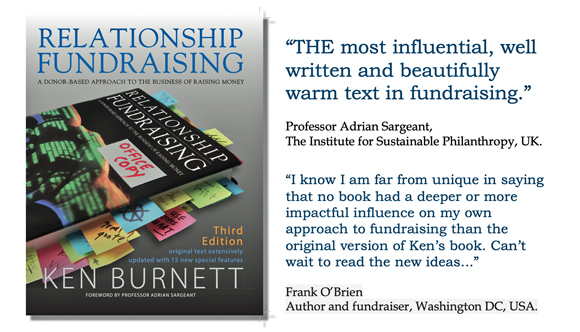|
‘That’s exactly it, ’ said the recently-retired Giles Pegram, ‘The secret of fundraising success is you have to invest enough and to stick around long enough to ensure that your investment can reap its full potential rewards.’
‘For the agency, this is usually no bad thing, for what we might lose on the swings we will usually gain on the roundabouts. A new client means a new round of pitching of course, which can be a bore, but if approached positively pitching can invigorate an agency. It’s expensive, of course, but as with everything else, the client always pays.’
For more blogs from Ken on fundraising and communication click here.
Books by Ken.Other feature articles.
And also a special
|
This article appeared in the July/August 2011 issue of Advancing Philanthropy, the quarterly magazine of the Association of Fundraising Professionals, in the USA. Staff retention: does it matter?
There’s a new venue in the UK where aspiring fundraisers gather. It’s a small Victorian hotel on the shores of famous Loch Ness, home to the infamous Loch Ness monster, in the heart of the Scottish Highlands. Last time I was up there I didn’t see Nessie, but I did come face to face with a real monster. This one is just as big and, for fundraisers, every bit as horrible because it can have an even more dramatic influence on our income than Nessie has on, say, the takings at the ‘Wee Beastie’ Tea Room in the nearby village of Fort Augustus. Only, the impact of this monstrosity is negative, not positive. The metaphorical monster in our loch is the scale and regularity of turnover of fundraising staff. Fundraisers retreat to the Inchnacardoch Country Lodge, Loch Ness, to study and dissect the major issues that aid or impede their daily work. The format and ambiance of these events is cathartic. Recently, at one of our major appeal laboratories there an intense Q&A session developed around the snug bar where, surrounded by eager fundraisers, my partner Alan Clayton ventured a seemingly off-the cuff response to a question from the group. ‘What,’ he was asked, ‘ is the real secret of success in fundraising?’ Alan didn’t hesitate. ‘It’s two things, he said. It’s
Giles Pegram, recently retired and most illustrious of all UK’s fundraising leaders, was in the room and responded immediately, ‘You have found me out, ‘ he confessed. ‘That is exactly it. The secret of fundraising success’ – he was now addressing the full assembly – ‘is you have to invest enough and you have to stick around long enough to ensure that your investment can reap its full potential rewards.‘ Giles should know. He’s just received a CBE from Her Majesty The Queen (that’s Commander of the Order of the British Empire, and her ma’amship doesn’t dish those baubles out to just anyone). Giles got his for transforming, over 30 years, the fundraising performance of one of Britain’s oldest and most respected charities, NSPCC, a feat he undertook not just once but twice in that time, launching two transformational major appeals both of which broke previous UK records for public fundraising. Each was in planning and execution for several years. The point is, you can’t even come close to implementing such campaigns if you are only around for 18 months. The secret of fundraising excellence really is as simple as this. If you would be a successful fundraiser, you have to stay put very much longer than most currently do. If you are a board member and want your organisation not just to thrive but to realise its full potential, you need to invest in your key fundraisers and keep them in post long enough for them to make a real rather than a cosmetic difference. How long is long enough? Well, at least five years just to really know the job and where it might lead. The time will vary of course with the organisation. But it is never short. Fundraising leadership is not for the short-term thinker. It never was. Career switching. Can fundraisers afford it? But in some ways, for the agency, this is usually no bad thing (I speak as a former agency head for 18 years, with mostly fundraising clients). For what we might lose on the swings we will usually gain on the roundabouts. A new client means a new round of pitching of course, which can be a bore, but if approached positively pitching can invigorate an agency. It’s expensive, of course, but as with everything else, the client always pays. (Dumb clients persist in imagining that the agency pays for all this posturing, but of course that is just foolishness. The client pays for everything, obviously, if you think about it. Which clients rarely do, perhaps because they’re not around long enough… If this subject appeals, see here what George Smith and SOFII have to say about the pitching process.) Changes in fundraising leadership also frequently lead to people changes further down the line. All the expensively trained middle management moves out just as they are learning the job and a new bunch of raw recruits enters, eager too to learn. Which is great for the training agencies. They thrive on this. Costly for the charity, for sure. It’s a bit like Groundhog Day. Because if, after a short while, you’re always returning to zero there’s never any real opportunity to get properly going, to find out what your day really could be. So what can we do about this?
There are probably very many other things we could do. But other agencies and consultancies, who all benefit from the constantly shifting sands of clientdom, will not thank me for going on, so I will end here. © Ken Burnett 2011
|
It isn’t so much a question of the balance between time and investment. Fundraisng organisations need both, and lots of them.
‘Each was in planning and execution for several years.
Disagree with Ken? Or agree with him, even? Have
At the time of writing Ken Burnett is a director of Clayton Burnett Limited, The White Lion Press Limited and he’s a former chairman of the board of trustees at the international development charity ActionAid. He’s author of several books including Relationship Fundraising and The Zen of Fundraising and is managing trustee of SOFII, The Showcase of Fundraising Innovation and Inspiration. For more on Ken’s books please click here. Readers of this blog familiar with my associated company The White Lion Press may already know about the recent fire at our office that destroyed 80 per cent of our books. Read about it here.
|





